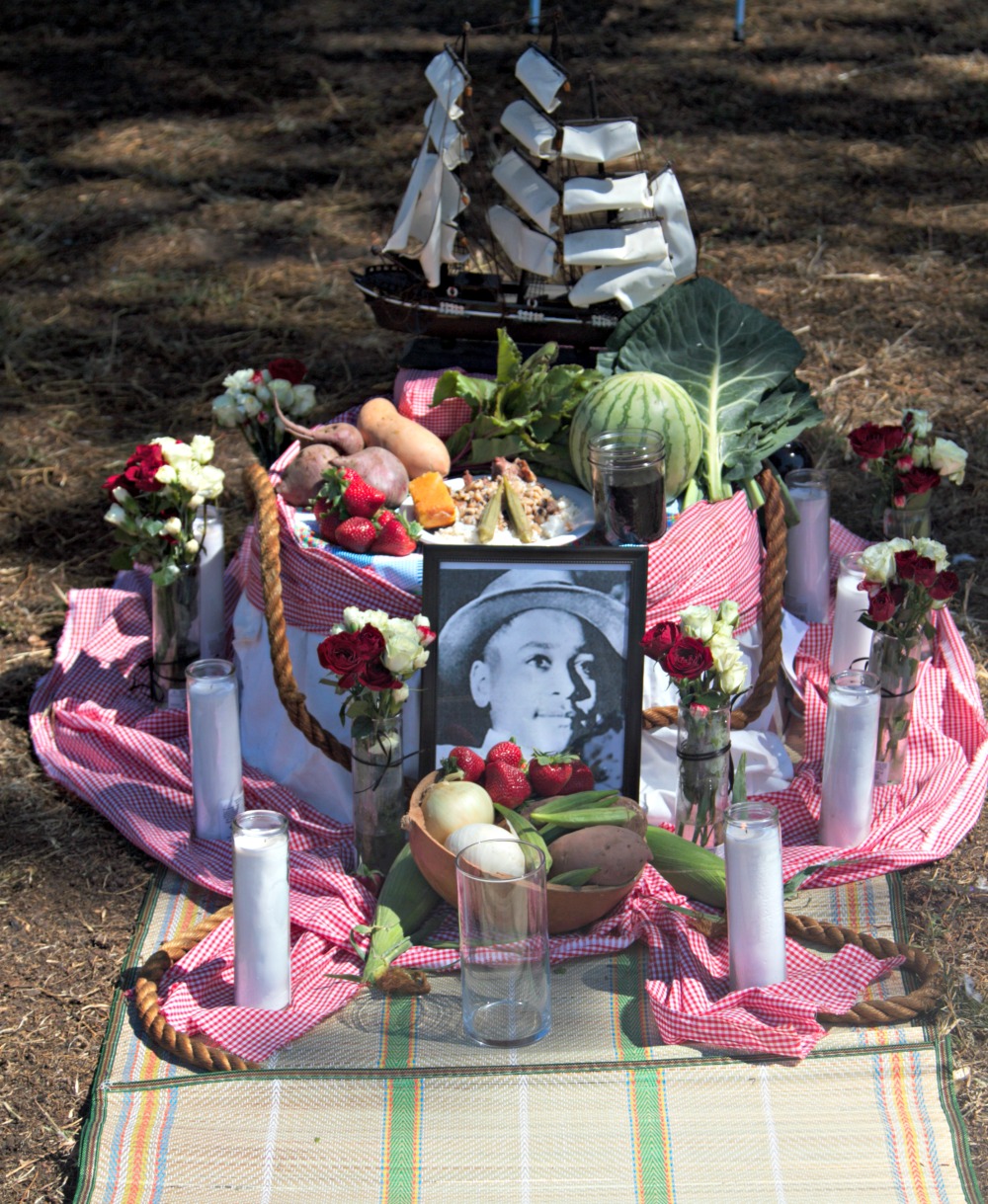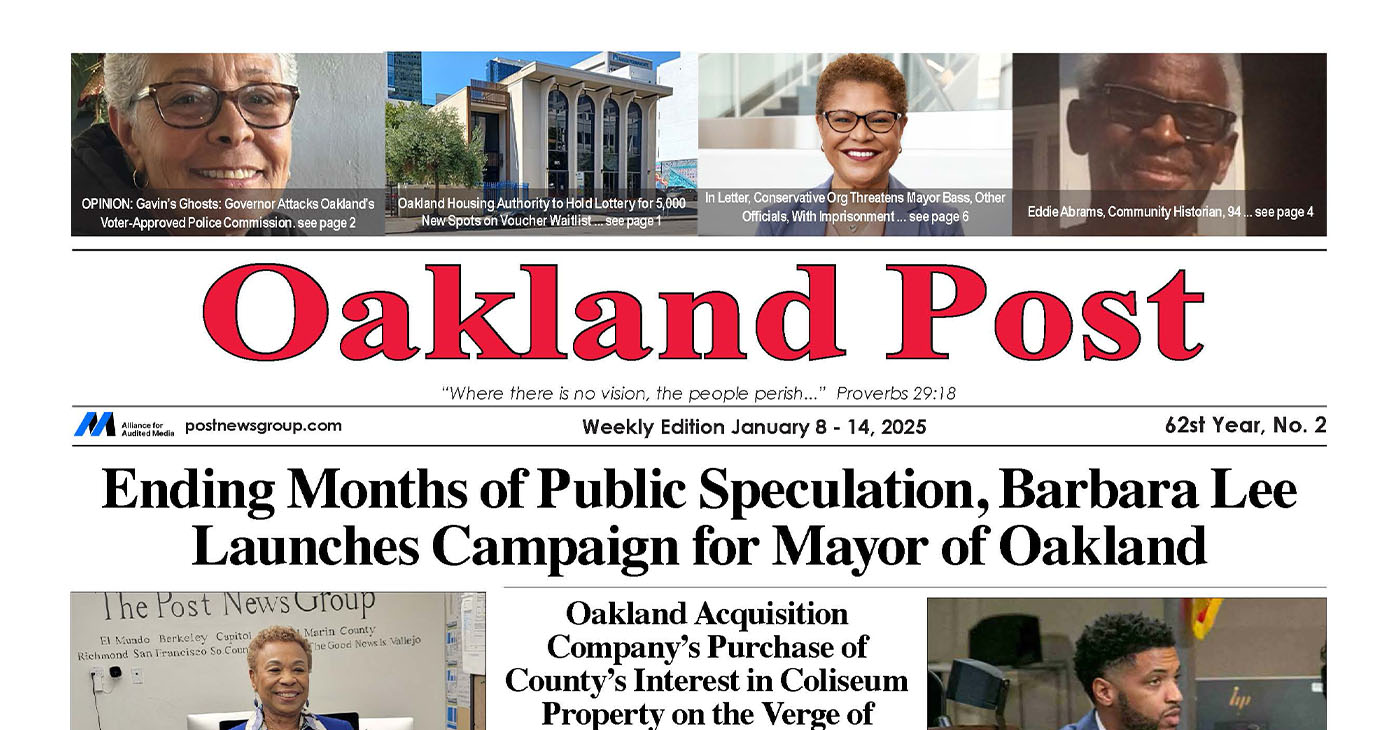Opinion
OPINION: Remembering the Sin and Shame of Lynching in America

The lynching rope is part of the altar for Omnira Institute’s ‘Ritual of Remembrance’ Juneteenth celebration on June 10 at Lake Merritt.
“Where there’s a will, there’s a way,” the old folks used to say when facing obstacles, often under their breaths.
“Where there’s a tree, there’s a rope,” is the next line, almost a rejoinder, acknowledging the constancy of unpredictable trouble, an expression fraught with grief, fear and loss.
One that a Black child born in the North in the 1950s didn’t know referred to the South’s “Strange Fruit.”
I am not sure if you can see it, the rope, on the altar, honoring and remembering the victims of white supremacy, lynched individually or in pairs or groups, these descendants of enslaved people whose only (proven) crime was to be Black. They were all killed by “person or persons unknown,” yet for decades after the Emancipation Proclamation, lynchings were very public events often occurring on the courthouse lawn.
 Town newspapers sometimes announced the day and time the spectacle would take place and trains were specially scheduled to transport the spectators: men, women, and even small children. Newspapers covered lynchings in graphic detail. Photographs showed desecrated bodies of Black people surrounded by triumphant sometimes even grinning white spectators. Again, “the persons unknown.” Black people certainly knew who terrorized them. The memory of such horrors haunted Black communities, a hobbling fear lasting generations. The frequency of the lynchings would stimulate the Great Migration, surging right after World War I.
Town newspapers sometimes announced the day and time the spectacle would take place and trains were specially scheduled to transport the spectators: men, women, and even small children. Newspapers covered lynchings in graphic detail. Photographs showed desecrated bodies of Black people surrounded by triumphant sometimes even grinning white spectators. Again, “the persons unknown.” Black people certainly knew who terrorized them. The memory of such horrors haunted Black communities, a hobbling fear lasting generations. The frequency of the lynchings would stimulate the Great Migration, surging right after World War I.
The most renown lynching was of 14-year-old Emmett Till in 1955, and the blood lust of the South appeared to wane under the withering scorn of the world. But the lynching of the Civil Rights workers in 1963 revealed otherwise as the search for their bodies in the river turned up many more, defiled, unidentified, unburied, unmourned. Like the tabloids showing the victorious crowds, social media in 2017 allows us to see ‘lynchings’ in real time.
There are so many, I honestly don’t have the heart to keep up.
Two weeks ago I glanced at an account on Facebook. Below three school portraits of impossibly young Black males, the headline was almost a taunt: “Did you know these youth were killed by the police this week? …Neither did we.” Then, on Monday I received another Facebook notice of a pregnant, mentally- challenged Black woman in Seattle killed by police in front of her other children.
I am doing my best, as our people say, to stay or be “woke,” but I confess I did not have the stomach to read further. It is 2017, and lynching not only continues, it is increasing. Like the mobs of the old days, police become judge, jury and executioner. Hidden under police department policy, the names of “persons unknown” are not released until the victim’s memory (ex. Mike Brown) is sullied.
On the rare occasion that police are actually tried for murder, lackluster prosecution ensures that they are seldom convicted. And now it’s not just the police, but individual white men who decide they want to kill Black people just because they feel like it. Timothy Caughman, a homeless Black man in New York, was stabbed to death in March by a man who came from Maryland for that express purpose.
In the 1920s and 1930s, not ‘giving ground’ to a white person, like refusing to step off the sidewalk or even bumping into a white girl while running to catch a train, were lynchable offenses, and it appears they are again. Five days before his graduation in May, Bowie State College student Richard Collins III was stabbed to death while waiting for an Uber ride for refusing to “yield ground” to a white University of Maryland student.
“Where there’s a will, there’s a way; where there’s a tree there’s a rope,” the old folks said.
I had been directed by spirit to make a noose with the coarse rope, but I didn’t know how. I am glad I didn’t. Symbolically, it would knot the possibility inherent in the third line, the last utterance of this trinity.
“Where there’s life, there’s hope.” Yes. And I hope that the ancestors understood.
Activism
Oakland Post: Week of January 8 – 14, 2025
The printed Weekly Edition of the Oakland Post: Week of January 8 – 14, 2025

To enlarge your view of this issue, use the slider, magnifying glass icon or full page icon in the lower right corner of the browser window.
Activism
Expect The Worst? Political Scientists Have a Pessimism Bias, Study Finds
The research, co-authored by UC Berkeley political scientist Andrew T. Little, offers a possible solution: an approach that aggregates experts’ predictions, finds the middle ground, and then reduces the influence of pessimism, leading to the possibility of “remarkably accurate predictions.”

Political experts surveyed recently were prone to pessimism — and were often wrong, says a study co-authored at UC Berkeley. Still, when their predictions were averaged out, they were ‘remarkably accurate’
By Edward Lempinen, UC Berkeley News
The past decade has seen historic challenges for U.S. democracy and an intense focus by scholars on events that seem to signal democratic decline. But new research released two weeks ago finds that a bias toward pessimism among U.S. political scientists often leads to inaccurate predictions about the future threats to democracy.
The research, co-authored by UC Berkeley political scientist Andrew T. Little, offers a possible solution: an approach that aggregates experts’ predictions, finds the middle ground, and then reduces the influence of pessimism, leading to the possibility of “remarkably accurate predictions.”
The study was released by Bright Line Watch, a consortium of political scientists who focus on issues related to the health of U.S. democracy. It offers provocative insight into political scientists’ predictions for the months ahead, including some that would be seen as alarming risks for democracy.
According to an analysis that Little distilled from a Bright Line Watch survey done after the November election, political scientists generally agreed that incoming Republican President Donald Trump is highly likely to pardon MAGA forces imprisoned for roles in the Jan. 6, 2021 uprising that sought to block the peaceful transfer of power from Trump to Democrat Joe Biden.
The research concluded that it’s less likely, but still probable, that Trump will pardon himself from a series of federal criminal convictions and investigations, and that his allies will open an investigation of Biden.
In understanding the future course of U.S. politics, Little said in an interview, it’s important to listen to the consensus of expert political scientists rather than to individual experts who, sometimes, become media figures based on their dire predictions.
“If we’re worried about being excessively pessimistic,” he explained, “and if we don’t want to conclude that every possible bad thing is going to happen, then we should make sure that we’re mainly worrying about things where there is wider consensus (among political scientists).”
Believe the Consensus, Doubt the Outliers
For example, the raw data from hundreds of survey responses studied by Little and Bright Line researchers showed that more than half of the political scientists also expected Trump to form a board that would explore the removal of generals; deport millions of immigrants; and initiate a mass firing of civil service government employees.
But once the researchers aggregated the scholars’ opinions, determined the average of their expectations and controlled for their pessimism bias, the consensus was that the likelihood of those developments falls well below 50%.
Bright Line Watch, founded in 2016, is based at the Chicago Center on Democracy and is collaboratively run by political scientists at the University of Chicago, Dartmouth College, the University of Michigan and the University of Rochester in New York.
The research collaboration between Little and the Bright Line Watch scholars sprang from a collegial disagreement that emerged last January in the pages of the journal Political Science and Politics.
Little and Anne Meng, a political scientist at the University of Virginia, authored a research paper in that issue positing that there is little empirical, data-based evidence of global democratic decline in the past decade.
At the request of the journal editors, scholars at Bright Line Watch submitted a study to counter the argument made by Meng and Little.
But in subsequent weeks, the two teams came together and, in the study released on Dec. 17, found agreement that raw opinion on the state of democracy skews toward pessimism among the political scientists who have participated in the surveys run by Bright Line Watch.
A Stark Measure of Pessimism (and Error)
Surveys conducted during election seasons in 2020, 2022 and 2024 asked political scientists to provide their forecasts on dozens of scenarios that would be, without doubt, harmful for democracy.
The raw data in the new study showed a high level of inaccuracy in the forecasts: While the political scientists, on average, found a 45% likelihood of the negative events happening, fewer than 25% actually came to pass.
Before last month’s election, Bright Line Watch asked the political scientists to assess dozens of possibilities that seemed to be ripped from the headlines. Would foreign hackers cripple voting systems? Would Trump or Vice President Kamala Harris, the Democratic candidate, declare victory before the winner was called by the news media? Would Trump incite political violence again?
Altogether, the political scientists predicted a 44% probability for the list of negative events — but only 10% actually happened.
In the interview, Little defended the focus on possible negative developments by political scientists and others. It’s “very important” to be aware of the potential for harmful developments, he said.
But the focus on worst-case scenarios can also be distracting and destabilizing. The question, then, is why political scientists might develop a bias for pessimism.
To some extent, Little said, it may be a matter of expertise. The data show that scholars who specialize in American politics tend to be the least pessimistic — and the most accurate — forecasters. Political scientists with expertise in international relations, political theory or other areas tend to be more pessimistic and less reliable.
Little offered several other possible explanations. For example, he said, when scholars focus on one narrow area, like threats to democracy, they might see the potential threats with a heightened urgency. Their worry might shape the way they see the wider political world.
“People who study authoritarian politics are probably drawn to that because they think it’s an important problem, and they think it’s a problem that we need to address,” he explained. “If you spend a lot of your time and effort focusing on bad scenarios that might happen, you might end up thinking they’re more likely than they really are.”
And occasionally, he said, scholars may find that raising alarms about imminent dangers to democracy leads to more media invitations.
The Battle for Scholars’ Public Credibility
For the interwoven fields of political science and journalism — and for the wider health of democracy — accuracy is essential. That’s the value of the analytical system described by the authors of the new study. If researchers can find the expert consensus on complex issues and tone down unwarranted alarm, understanding should improve, and democracy should operate more efficiently.
Still, Little cautioned, it would be a mistake to discount or discard the insights offered by expert political scientists.
“You don’t want to say, ‘I’m just going to ignore the experts,’” he advised. “This research shows that that would be a very bad idea. Once you do the adjustments, the experts are very informed, and you can learn a lot from what they say.
Arts and Culture
Book Review: Building the Worlds That Kill Us: Disease, Death, and Inequality in American History
Nearly five years ago, while interviewing residents along the Mississippi River in Louisiana for a book they were writing, authors Rosner and Markowitz learned that they’d caused a little brouhaha. Large corporations in the area, ones that the residents of “a small, largely African American community” had battled over air and soil contamination and illness, didn’t want any more “’agitators’” poking around. They’d asked a state trooper to see if the authors were going to cause trouble.

By Terri Schlichenmeyer
Author: David Rosner and Gerald Markowitz, c.2024, Columbia University Press, $28.00
Get lots of rest.
That’s always good advice when you’re ailing. Don’t overdo. Don’t try to be Superman or Supermom, just rest and follow your doctor’s orders.
And if, as in the new book, “Building the Worlds That Kill Us” by David Rosner and Gerald Markowitz, the color of your skin and your social strata are a certain way, you’ll feel better soon.
Nearly five years ago, while interviewing residents along the Mississippi River in Louisiana for a book they were writing, authors Rosner and Markowitz learned that they’d caused a little brouhaha. Large corporations in the area, ones that the residents of “a small, largely African American community” had battled over air and soil contamination and illness, didn’t want any more “’agitators’” poking around. They’d asked a state trooper to see if the authors were going to cause trouble.
For Rosner and Markowitz, this underscored “what every thoughtful person at least suspects”: that age, geography, immigrant status, “income, wealth, race, gender, sexuality, and social position” largely impacts the quality and availability of medical care.
It’s been this way since Europeans first arrived on North American shores.
Native Americans “had their share of illness and disease” even before the Europeans arrived and brought diseases that decimated established populations. There was little-to-no medicine offered to slaves on the Middle Passage because a ship owner’s “financial calculus… included the price of disease and death.” According to the authors, many enslavers weren’t even “convinced” that the cost of feeding their slaves was worth the work received.
Factory workers in the late 1800s and early 1900s worked long weeks and long days under sometimes dangerous conditions, and health care was meager; Depression-era workers didn’t fare much better. Black Americans were used for medical experimentation. And just three years ago, the American Lung Association reported that “’people of color’ disproportionately” lived in areas where the air quality was particularly dangerous.
So, what does all this mean? Authors David Rosner and Gerald Markowitz don’t seem to be too optimistic, for one thing, but in “Building the Worlds That Kill Us,” they do leave readers with a thought-provoker: “we as a nation … created this dark moment and we have the ability to change it.” Finding the “how” in this book, however, will take serious between-the-lines reading.
If that sounds ominous, it is. Most of this book is, in fact, quite dismaying, despite that there are glimpses of pushback here and there, in the form of protests and strikes throughout many decades. You may notice, if this is a subject you’re passionate about, that the histories may be familiar but deeper than you might’ve learned in high school. You’ll also notice the relevance to today’s healthcare issues and questions, and that’s likewise disturbing.
This is by no means a happy-happy vacation book, but it is essential reading if you care about national health issues, worker safety, public attitudes, and government involvement in medical care inequality. You may know some of what’s inside “Building the Worlds That Kill Us,” but now you can learn the rest.
-

 Activism3 weeks ago
Activism3 weeks agoBooks for Ghana
-

 Arts and Culture4 weeks ago
Arts and Culture4 weeks agoPromise Marks Performs Songs of Etta James in One-Woman Show, “A Sunday Kind of Love” at the Black Repertory Theater in Berkeley
-

 Bay Area3 weeks ago
Bay Area3 weeks agoGlydways Breaking Ground on 14-Acre Demonstration Facility at Hilltop Mall
-

 Activism4 weeks ago
Activism4 weeks ago‘Donald Trump Is Not a God:’ Rep. Bennie Thompson Blasts Trump’s Call to Jail Him
-

 Activism3 weeks ago
Activism3 weeks agoLiving His Legacy: The Late Oscar Wright’s “Village” Vows to Inherit Activist’s Commitment to Education
-

 Arts and Culture3 weeks ago
Arts and Culture3 weeks agoIn ‘Affrilachia: Testimonies,’ Puts Blacks in Appalacia on the Map
-

 Alameda County3 weeks ago
Alameda County3 weeks agoAC Transit Holiday Bus Offering Free Rides Since 1963
-

 #NNPA BlackPress4 weeks ago
#NNPA BlackPress4 weeks agoCalifornia, Districts Try to Recruit and Retain Black Teachers; Advocates Say More Should Be Done









































